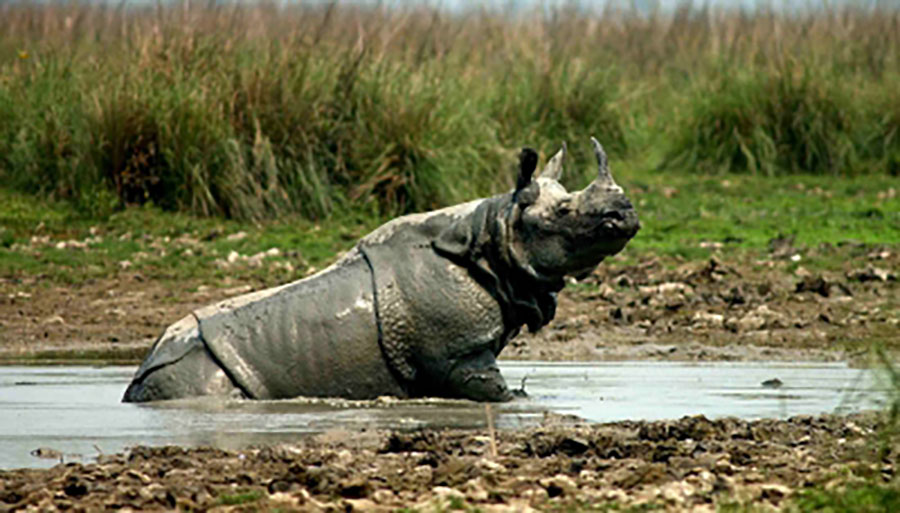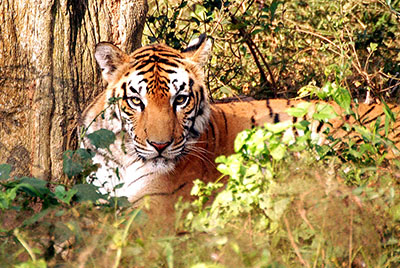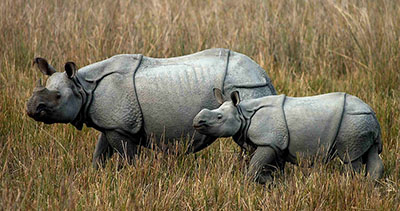
The tall clumps of grass rippled in the mild winter sunshine as I swayed drunkenly on the elephant’s back.
The sky was a clear blue except for a few puffs of clouds chasing each other like playful children and my daughter insisted one of them looked like a baby Rhino. We had come to Kaziranga in Assam in search of the mighty animal but so far seen only a few wild boars having fun in the muddy swamps.
Kaziranga, with its endless grassy swamps edged by green forests, is one of the most beautiful National Parks I have ever visited. A fine mist hangs in the air and one feels as if the earth has just been formed and you are the first creatures on it. Then, suddenly, the mighty rhino appears in this peaceful landscape dressed in its formidable gear. This massive and powerful animal has not changed its appearance much from the prehistoric age and seems quite content the way it looks. It ignores us but casts a brief glance at our elephant, who snorts a rude greeting.
 Then we both move away, much to my relief. The Indian one-horned rhinoceros is one of the reasons most people come from all over the world to visit the Kaziranga National Park. The animal was shot and killed in large numbers by poachers and its population began to decline rapidly but in 1926 its habitat was declared a reserve forest and later in 1940 it became a wildlife sanctuary. The animal has a safe habitat now, though there are still many incidents of poaching; the rhino horn fetches a lot of money in the international market.
Then we both move away, much to my relief. The Indian one-horned rhinoceros is one of the reasons most people come from all over the world to visit the Kaziranga National Park. The animal was shot and killed in large numbers by poachers and its population began to decline rapidly but in 1926 its habitat was declared a reserve forest and later in 1940 it became a wildlife sanctuary. The animal has a safe habitat now, though there are still many incidents of poaching; the rhino horn fetches a lot of money in the international market.
Unaware of all this danger, our rhino munched a green plant with a thoughtful air and then slowly waddled off to a muddy pool nearby. It stood for a minute and then slowly sank into the mud. I was sure I could hear it sigh with joy. Its thick armour-like hide is soon covered with grey mud which matches the colour of its skin. A pretty white egret lands on its back and begins to check this moving tank for edible items.
 Suddenly, there is a loud screeching noise which shatters the peace of the swampy land, and a gang of Rose–ringed parakeets fly past us. This annoys the group of swamp partridges who begin to call out angrily.
Suddenly, there is a loud screeching noise which shatters the peace of the swampy land, and a gang of Rose–ringed parakeets fly past us. This annoys the group of swamp partridges who begin to call out angrily.
We now head slowly towards the forest where strange and beautiful flowering creepers hang from the trees. Assam has an amazing variety of rare plants which are not seen in rest of the country. During the last century many British plant hunters risked their lives just to be able to gather the seeds of some rare exotic flowers. The Rhododendron shrub travelled from the forests of Assam all the way to England and became their favourite garden plant.
Meanwhile, I see a Yellow-billed Blue Magpie lurking in the shadows and just next to us a pair of beautiful little Flower-peckers flits about in search of nectar. Their green, yellow and scarlet feathers gleam like jewels in the gentle light. Assam, with its ever changing landscape, offers so much that the mighty Rhino and the elegant little Flower-pecker along with many other birds and animals are all happy to bask in its eternal bounty.
Bulbul Sharma is an author and a painter. Her books like Anger of Aubergines, My Sainted Aunts, The Perfect Woman are mainly for children. Apart from occasionally conducting art activities for children, she also finds time to tend her orchard in the Himalayan hills where she grows fruits and herbs.

